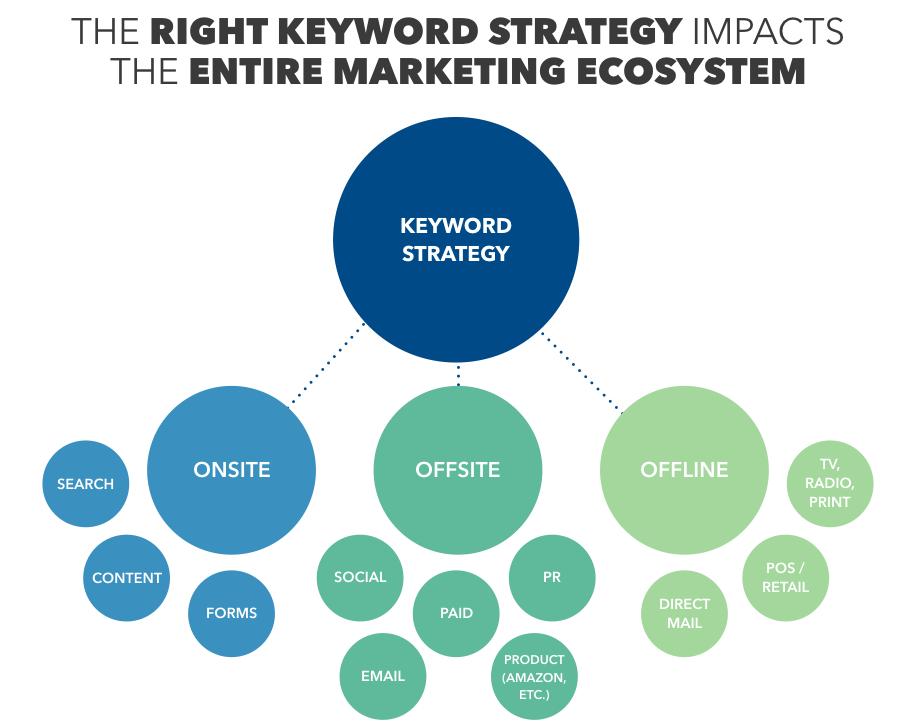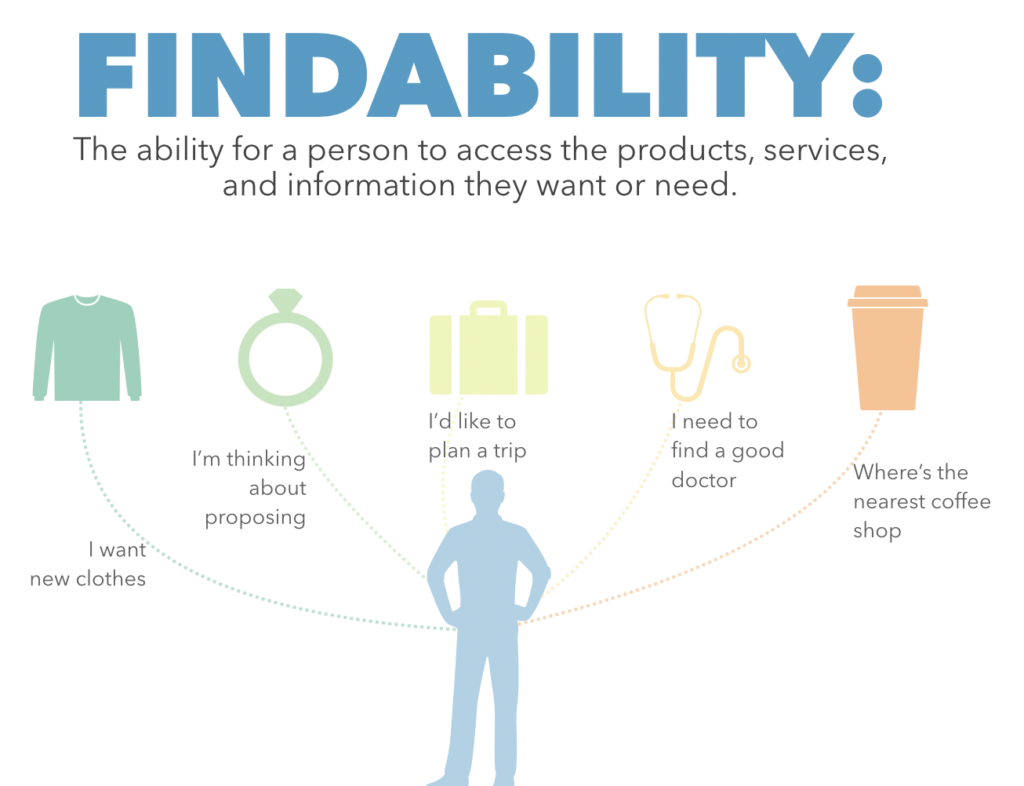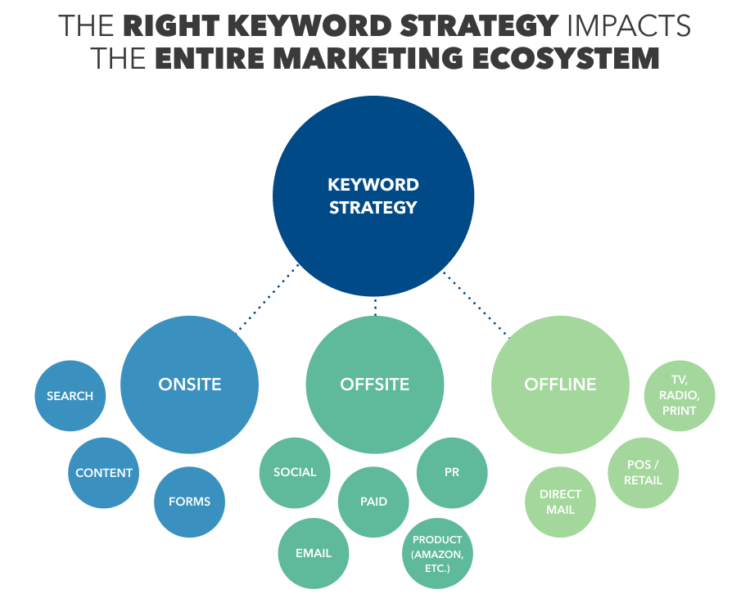To say that keyword strategy is critical to the success of marketing and advertising is no overstatement. Keyword strategy involves an understanding of why your organization offers what it offers, how it resonates with audiences, what it looks like your target market with relationship to competitors, and measures the efficacy of your efforts.
Watch the Found Friday episode here.
Setting the foundation of findability – the key to true marketing success
When we’re talking about a good keyword strategy, we’re talking about addressing all of those elements in a way that touches each aspect of your marketing ecosystem. That’s right, it’s not just for content marketing and SEO – it’s for everything! But more on that as we move through the series.
Let’s take a look at a few examples of why that’s the case before we go further, in case you need some convincing.
60% of cable box owners are watching “dual screens”which means they’re watching TV and using a phone, laptop, or tablet device. If they see something interesting on TV, they’re looking for more information about it on Google, Facebook, YouTube, or Amazon.
If we see something online from advertisements, email, social feeds, or videos, and then encounter in a store or offline environment – we are 90% more likely to engage!
The right keyword strategy and research process impacts your entire marketing flow – onsite, offsite, and offline content can all be improved with this process.

Defining Findability
Okay, so back to findability. What is findability and how do we impact it in today’s marketing world?
Findability is the ability for someone to find what they’re looking for at the time and in the place that they’re looking for it.
We’ve been dealing with findability since the beginning of human’s ability to communicate. We have always wanted to find food, water, shelter, a mate, safety… And we knew where to look for the advice of others – rocks, trees, cave walls, and other known places for markings.

As we evolved those places became town criers, church doors, bulletin boards, phone books, classified ads, message boards, chat rooms, and forums.
Our need to seek out information and make decisions based on recommendations is hardwired into our daily life.

Rank Tracking & Competitor Insights Delivered Daily
The evolution of search and findability
So fast forward to today, with search engines of various types are commonplace, and the ways we interact with them are evolving. Whether it’s on our desktop or tablet, a mobile device, or using voice search – we’re still asking questions and getting answers – and there’s a multi-billion dollar business dedicated to delivering those answers.
Our most easily recognizable search engine, Google, is far from the only game in town. Outside of other traditional search engines like Yahoo or Bing, there are international search engines that rival Google for market-share in their target countries – such as Baidu, Sogou, Qihoo 360, Daum, Naver, and Yandex.

Moving away from traditional search engines, we have sites that are heavily trafficked that use their own algorithms such as Amazon, with the A9 algorithm, Pinterest, as well as several review sites which are popular in APAC countries.
Amazon’s dominance of product-based search, and the rise of comparison shopping sites like Jet, and even Walmart.com, make findability a big deal that is spread across multiple marketing channels.
How do we impact findability today?
We can most easily impact:
- How we’re found – This is the breakdown of channels that we choose to engage with audiences across. This doesn’t mean our products, services, and brand can’t be found in other areas, but the website, radio, TV, social media, email, and other areas we are actively engaging on are a primary way we’re found.
- What the audience finds – The content that the audience finds when they’re searching for something is within our control as well. We can create websites, ads, fliers, videos, and content of all types for a variety of channels. Creating the type of content that our audience wants to find, in a format that is findable, and on a channel they’re on is the ultimate responsibility of the marketing team.
How do we make findability work for us?
We start with two things:
- What we’re offering
- Who’s looking for it
If you’re still in the product or service development phase – this is even better! (Any time you launch a new product or services this should be your first step.)
This audience discovery is often an afterthought or is hurried through in an attempt to get to “the results stuff.” Another reason folks hurry through it? They assume they’ve got an audience and that they can describe them in a few demographics already – so they’ll dig in more later if they need it.
You need it now. Here are three big reasons why:
- Even if you’re successful, you could still be leaving opportunities on the table or spending more than you have to for conversions.
- If you’re an established business with a built in base, you may be missing new markets because you’re focused on past audiences
- If you’re struggling you may think you don’t have time or resources for this and you’re focused on “quick wins” but those will only keep netting results if you’re paying for them and if you’re using the right findability targets to begin with
I’ll take a pause here for an important differentiation – which is your current target audience versus your potential audience. (There’s often overlap.)
Your current target audience is made up of people who are engaging, successfully or otherwise, with your brand, products, services, and content. In contrast, your potential audience is made up of anyone who is searching for, needs, or wants your offerings. Whether you’ve identified them or not.
What’s great about this is that your potential audience is always bigger than your current target audience – which means you could be selling more.
We will dive into the market ecosystem and how our audience interacts with it as it pertains to keywords shortly – but for now, I’ll just mention that there are several ways to assess the current and potential audiences that you have across engagement types, including onsite, offsite, and offline channels. I’ve included some examples of each here to remind us of just how many of these there really are for people to interact with daily!

Not Ranking? Start Winning The SERP Today!
Findability: Starting with audience analysis to build keyword strategy
Let’s talk about the audience in more concrete terms. I’ve found that every data point or metric we care about measuring rolls up into one of these five areas, and we need to understand these core things, no matter how we get there:
- How do people currently find what they’re looking for? – What terms and phrases are they using, how does that change, does location impact it, etc.
- Who are they finding – us, competitors? – Are they direct or indirect competitors? If it’s us, is the most appropriate landing page?
- What are they finding? What type of content are they finding – is it videos, blog posts, product pages, contributed articles, forum articles or universal search elements?
- Are they happy with what they’re finding? – Do they bounce, do they convert, are they return visitors, do they take an action?
- Could they be happier? – A lot of people don’t stop and think about this one because they’re happy they got through the first four. But it’s really important because you’ve come this far and we don’t want to leave money on the table. Have we considered each audience and what their journey might be? Have we given them logical options at each stage that correspond with their expectations?
For today, we’re going to talk about the first core element:
How do people currently find what they’re looking for?
Understanding how audiences are finding what they’re looking for now is what drives our focus on keyword strategy.
Much of how we find what people are looking for is keyword driven, even outside of the search engine space.
Keywords – which can also be phrases – are essentially a breakdown of how we describe our daily lives. That includes products, services, information, and even entertainment.
Let’s look at a few examples.
Product

If someone is looking for a product, they may describe that in a variety of ways, including:
- Scotts Miracle Gro Plus Weed Killer
- Best weed killing spray that’s safe for my lawn
- How do I get rid of weeds on my lawn?
- Why does my lawn look brown?
- Is this a weed or a good plant?
You’ll notice that some of these examples are very direct – they either name the product or the problem directly. Others are more informational or vague. These are actually some golden opportunities for most brands to create inroads with their target audience.
Either way, these may be part of searches on a search engine, or conversations with others, point of purchase materials, commercials, or something else.
Services
When people are talking about services, they may not even know they need a service, for example:
- Best hairstyles for weddings
- How do I fix the SEO issues on my site
- Fixing a leaking faucet
These are times when service providers, and local search to a large instance, have an opportunity to provide information and then upsell to an audience who needs that information. You’ll also see instances where someone will give the information away on how to do something but then offer to do it for a discount. All great examples of leveraging the intent of the audience to gain conversions.
Service providers have several options in today’s marketing climate to use keyword research and smart content creation to gain a competitive advantage, and we’ll explore those more throughout the series.
Information
Asking questions is human nature. We ask on Google, we ask for the best version of products on Amazon, we ask for recommendations on Facebook, we consult store owners, user reviews, restaurant waiters, and more. Information is the broadest query and a lot of people are nervous about the information category because it’s vastness feels daunting.
Let’s look at it as an opportunity to give the people what they want. The right answer at the right time.
Similar to listening to a sommelier about a wine selection or a highly recommended realtor about a house purchase, the key is trust. If you ask the sommelier about a wine suggestion and he brings you an amazing bottle, and bonus points if he’s within your price range – he gets a point in the trust column. If you follow through on a realtor’s recommendation to purchase a home and get burned on the inspection then that realtor isn’t going to get recommended by you any time soon.
This is how search engines work. They want to build trust with you – domain authority – and know that they can reliably send people to your site for answers.
In this aspect, using search data for the information category is the first stop on building killer content.
We’ll come back to this as we move through our keyword strategy development this week.
Entertainment
We all do it, we get bored or need a break and we need a distraction or something fun to watch or read. We scroll through Instagram, Pinterest, Facebook, and Twitter. We search YouTube for videos, we share stories with our friends and family. We buy magazines, we watch TV. All of these are driven by keywords – even if we’re not selecting them.
Our news feeds, screens, local bookstores, and guides are filled with thematic keywords that, in many instances, are tailored to known audience behavior. While this is more personalized for online options and social media in particular, it still happens for offline modes – especially as the online and offline world mix with television, radio, and our suggestions for reading content through point of sale innovation.
Since today is all about setting the foundation for keyword strategy, we’re going to close today with a look at how keywords impact our marketing ecosystem and a quick preview of the Segment Map methodology that we’ll be delving into next week.
As we’ve just discussed, we’re always searching for something – whether it’s informational, entertaining, or products, and services directly. The unique descriptions of these wants, needs, and wonderings is our personal lexicon of keywords. It varies across regions, age ranges, genders, and socio-economic status.
The way the search community, and search engines, define keywords has evolved over the past few decades. Take into account the increase in keyword length on Google from a single word, or two, to a sentence or phrase in just one generation. Most in the search space see this as a small increase as voice searches rise and tend to be longer.
We could say all the searches have been done right, there are 3.5 billion searches on Google alone each year – what could possibly be new? Well… Every year, somewhere between 16% and 20% of Google searches are new—they’ve never been searched before.

That points to this evolution of our language and ways of describing things even more. We’re finding millions of new ways to search for approximately the same wants and needs we had the year before.
That’s a green field opportunity for marketers as we look for “long tail” keywords. The long tail are those keywords that are more descriptive, state intention most clearly, and are most likely to convert. They drive content creation online AND offline. How can we not love building a keyword strategy with that much opportunity?!
Someone asked me for an example of a longtail keyword in the offline world and I say you need not look any farther than a local Barnes and Noble bookstore. Book titles are the original page titles – our paper h1s. Go to the cooking section.
You’ve got cookbooks by food ethnicity, course, diet type, disease, celebrity, and more. Within each of those it’s even more specific. You’ve got Italian food classics, Italian pasta, vegetarian Italian, Italian desserts, Italian for diabetics, Italian recipes for the keto diet – it goes on and on. These are keywords. Italian recipes and Italian cookbooks are our head keywords and Italian recipes for the keto diet are our long tail. And I can bet you someone looked into how many people wanted Italian food for the keto diet before investing in publishing that book. Keyword research, it’s alive and well! And basically an extension of our old school market research through surveys and focus groups – which I also STILL like as a practice.
Now that we understand how widespread and impactful our keyword selection is in our product and messaging – we’ll move next week to the development of this strategy. We’ll talk about the research, and methodologies, in finding and selecting keywords. We’ll also touch on who in your organization should be involved in the process or see the results.
If you’re not registered for Found Fridays, you can join us each week by registering here. You will automatically get access to all resources, articles, future series, and more.
Need some help with keyword strategy and research? Check out the DemandSphere solution set here.
